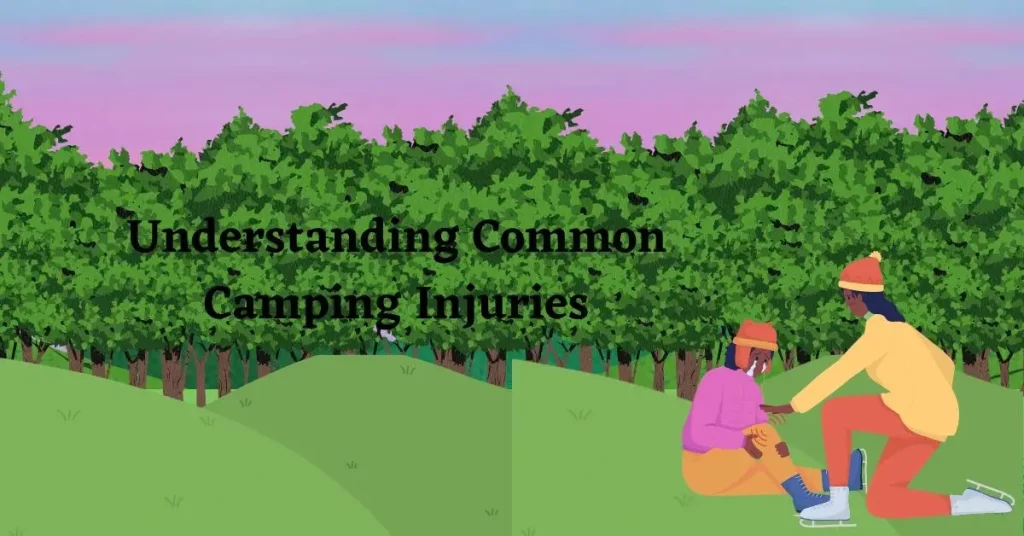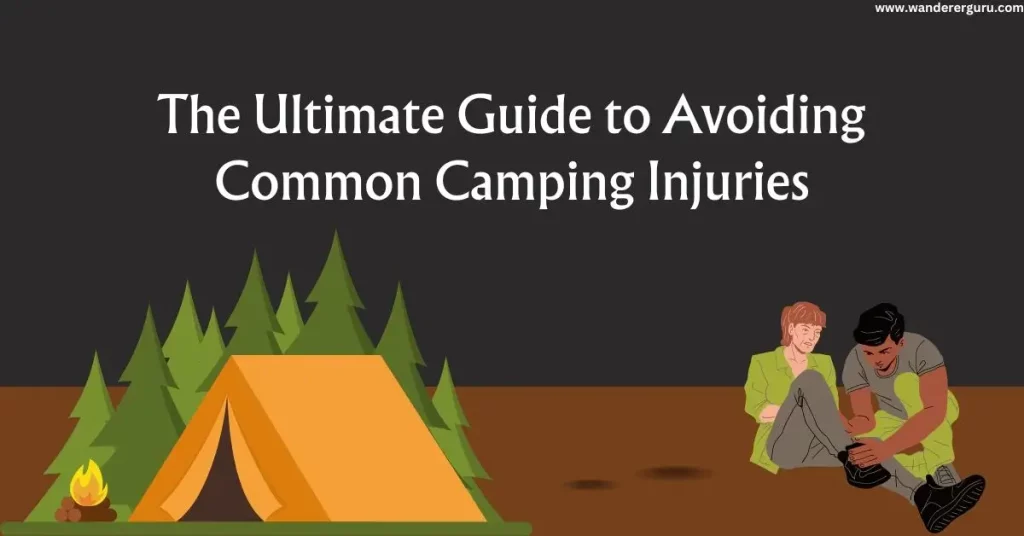You can’t really camp if you’re suffering with common camping injuries even though camping is a great outdoor activity enjoyed by many people around the world. It allows us to connect with nature, relax, and escape from the daily grind. However, just like any outdoor activity, camping comes with its risks. Injuries can occur, ranging from minor cuts and scrapes to more severe accidents.
This article will explore common camping injuries, their prevention, and first aid tips to ensure a safe and enjoyable camping experience.
Understanding Common Camping Injuries

Rash After Camping
Camping can expose us to various allergens and irritants that may result in a rash. Common causes include contact with poisonous plants like poison ivy or oak, insect bites, or exposure to certain chemicals. If you develop a rash after camping, follow these steps:
- Cleanse the impacted region using gentle soap and water.
- Apply a cold compress to decrease itching and inflammation.
- Use over-the-counter hydrocortisone cream to alleviate discomfort.
- If the skin irritation continues or intensifies, it is advisable to seek medical assistance.
Sunburn: Ankles Can’t Walk
Spending time outdoors exposes our skin to harmful ultraviolet (UV) rays from the sun, which can lead to sunburn. Sometimes, we forget to protect certain areas, like our ankles, resulting in severe sunburn that makes walking painful. Here’s what you can do:
- Move to a shaded area to avoid further sun exposure.
- Take cool showers or apply cold compresses to soothe the burned area.
- Apply aloe vera gel or moisturizing lotion to hydrate the skin.
- Wear loose-fitting, breathable clothing to prevent further irritation.
- If the pain is severe or blisters develop, seek medical attention.
Camping Accidents
Accidents can occur even on the most careful camping trips. Being prepared can make a significant difference, whether a fall, a sprained ankle, or a burn. Here are some essential items to include in your camping first aid kit:
- Adhesive bandages in various sizes
- Sterile gauze pads and adhesive tape for wound dressing
- Antiseptic wipes or solution for cleaning wounds
- Tweezers for removing splinters or ticks
- Instant cold packs for reducing swelling
- Pain relievers, such as ibuprofen or acetaminophen
- Scissors and safety pins
- Emergency blanket
- First aid manual or guide
Remember, having a well-stocked first aid kit and basic knowledge of first aid can help you respond effectively in case of camping accidents.
Camping Preparation
Proper preparation is essential to prevent injuries while camping. Make sure to research your destination, understand the terrain, and be aware of potential risks. Plan and pack accordingly, including appropriate footwear, clothing, and gear. Being well-prepared significantly reduces the likelihood of accidents and injuries.
Bonus:
How To Keep Milk Cold When Camping? Golden Guide
Dealing with Camping Injuries
Diarrhea After Camping: Dealing with Digestive Issues
Digestive issues, such as diarrhea, can sometimes occur during or after camping due to contaminated food or water. To manage diarrhea while camping, consider the following:
- Stay hydrated by drinking plenty of clean, safe water.
- Avoid alcohol, caffeine, and sugary drinks, which can worsen symptoms.
- Eat bland, easily digestible foods like rice, bananas, and toast.
- Use over-the-counter anti-diarrheal medication if necessary.
- In case the symptoms persist or worsen, it is crucial to seek medical assistance, as dehydration can pose a significant risk.
Camping First Aid Kit
Having a well-stocked first aid kit is essential when camping. It should include bandages, adhesive tape, antiseptic wipes, pain relievers, tweezers, and insect repellent. Familiarize yourself with the contents of your kit and learn basic first-aid techniques. Being prepared will enable you to respond promptly and effectively to minor injuries or emergencies.
Cuts and Scrapes: First Aid Basics
Minor cuts and scrapes are common during outdoor activities like camping. Proper first aid can promote faster healing and prevent infection. Follow these steps for cuts and scrapes:
- Wash your hands with soap and water or use hand sanitizer before treating the wound.
- Cleanse the wound using mild soap and water to eliminate dirt and debris.
- To prevent infection, apply an over-the-counter antibiotic ointment.
- Cover the damage with a sterile bandage or dressing.
- Change the dressing regularly and monitor for signs of infection, such as rise pain, redness, or pus.
- Seek medical attention whether the wound is deep, bleeding heavily, or showing signs of infection.
Staying Safe During Camping Activities
Dancing Injuries: Watch Your Steps
Dancing around the campfire can be enjoyable, but caution’s essential to prevent injuries. Choose a clear and level area for dancing, away from any hazards. Wear appropriate footwear that provides support and traction. Avoid vigorous or risky dance moves that could lead to sprains, strains, or falls. Remember, safety should always be a priority, even while having fun. For more ideas, visit my Pinterest.
Kayaking Injuries: Stay Safe on the Water
Kayaking is a popular water activity during camping trips but carries inherent risks. Before venturing out:
- Ensure you have the necessary skills and knowledge of kayaking techniques.
- Wear a properly fitted personal flotation device (PFD) at all times.
- Be aware of water conditions, potential obstacles, and weather changes.
- Follow safety guidelines and paddle with a buddy whenever possible.
Swimming: Possible Injuries and Prevention
Swimming is a refreshing and enjoyable camping activity, but it’s essential to be aware of potential injuries and take preventive measures. Be cautious of strong currents, underwater hazards, and sudden changes in water depth. Never swim alone and always supervise children. Learn basic water rescue techniques and CPR. If you’re unsure about your swimming abilities, consider wearing a life jacket for added safety.
Conclusion
Camping is an incredible opportunity to connect with nature and create lasting memories. BAwarenessof common camping injuries and taking essential precautions can ensure a safe and enjoyable experience. Remember to pack a well-stocked first aid kit, practice good hygiene, and take preventive measures based on the activities you plan to engage in. Stay vigilant, prioritize safety, and maximize your camping adventure.
FAQs
Q.1 What should I do in case of a camping accident?
Ans: In case of a camping accident, follow these steps:
- Assess the situation and prioritize safety.
- Administer first aid as necessary.
- Call for emergency medical help if needed.
- Keep the person calm and comfortable until help arrives.
- Provide essential information to medical professionals.
Q.2 What should I do if I encounter poison ivy or oak while camping?
Ans: If you come into contact with poison ivy or oak, wash the affected area immediately with soap and water. Avoid scratching the rash, and apply calamine lotion or hydrocortisone cream to reduce itching. If the inflammation persists or worsens, consult a healthcare professional.
Q.3 Are there any safety tips for camping near water bodies?
Ans: Be cautious when camping near water bodies like lakes or rivers. Always supervise children around water, wear a life jacket when boating or swimming, and be aware of hazards like underwater rocks or currents. Learn basic water safety techniques and follow local regulations and guidelines.
Bonus:

